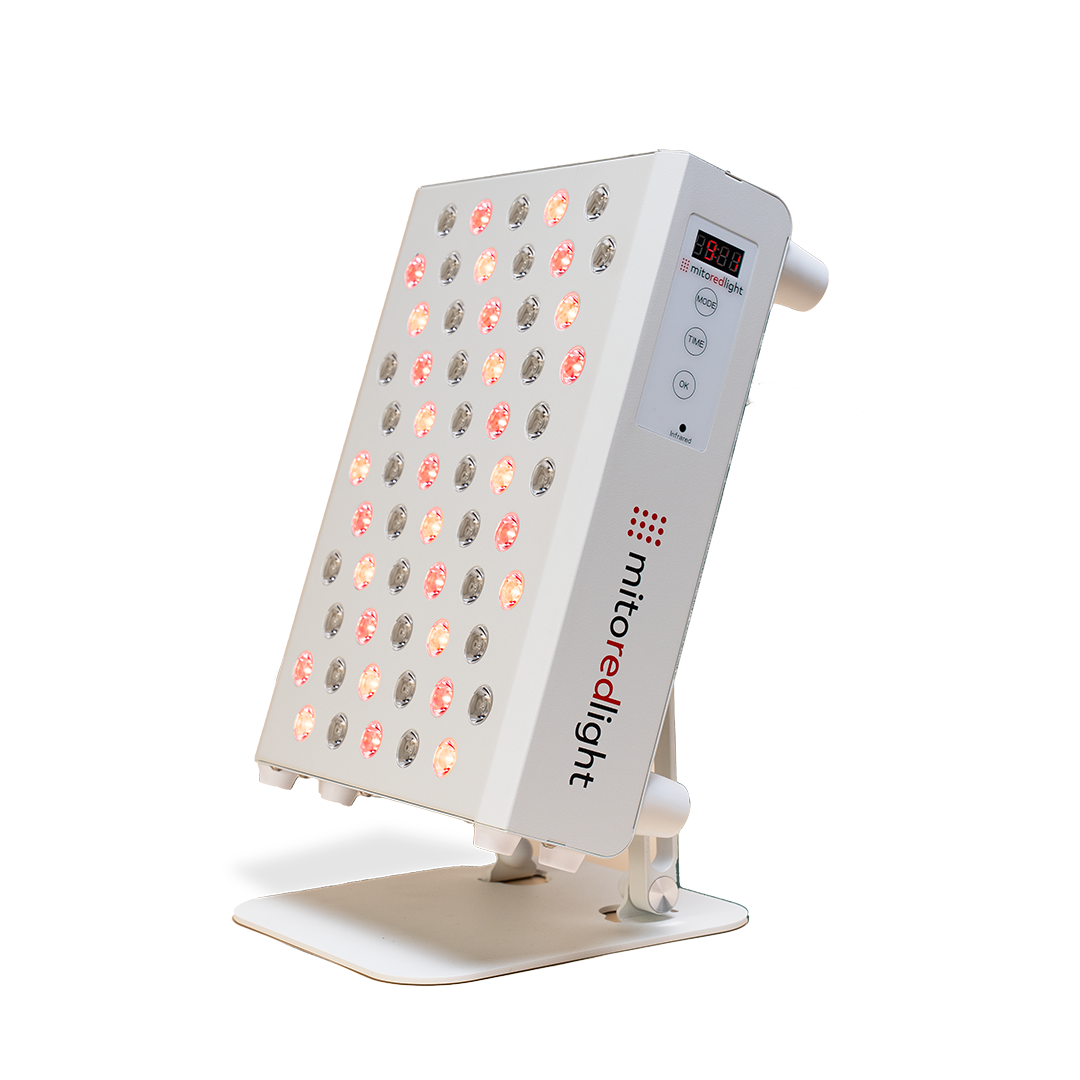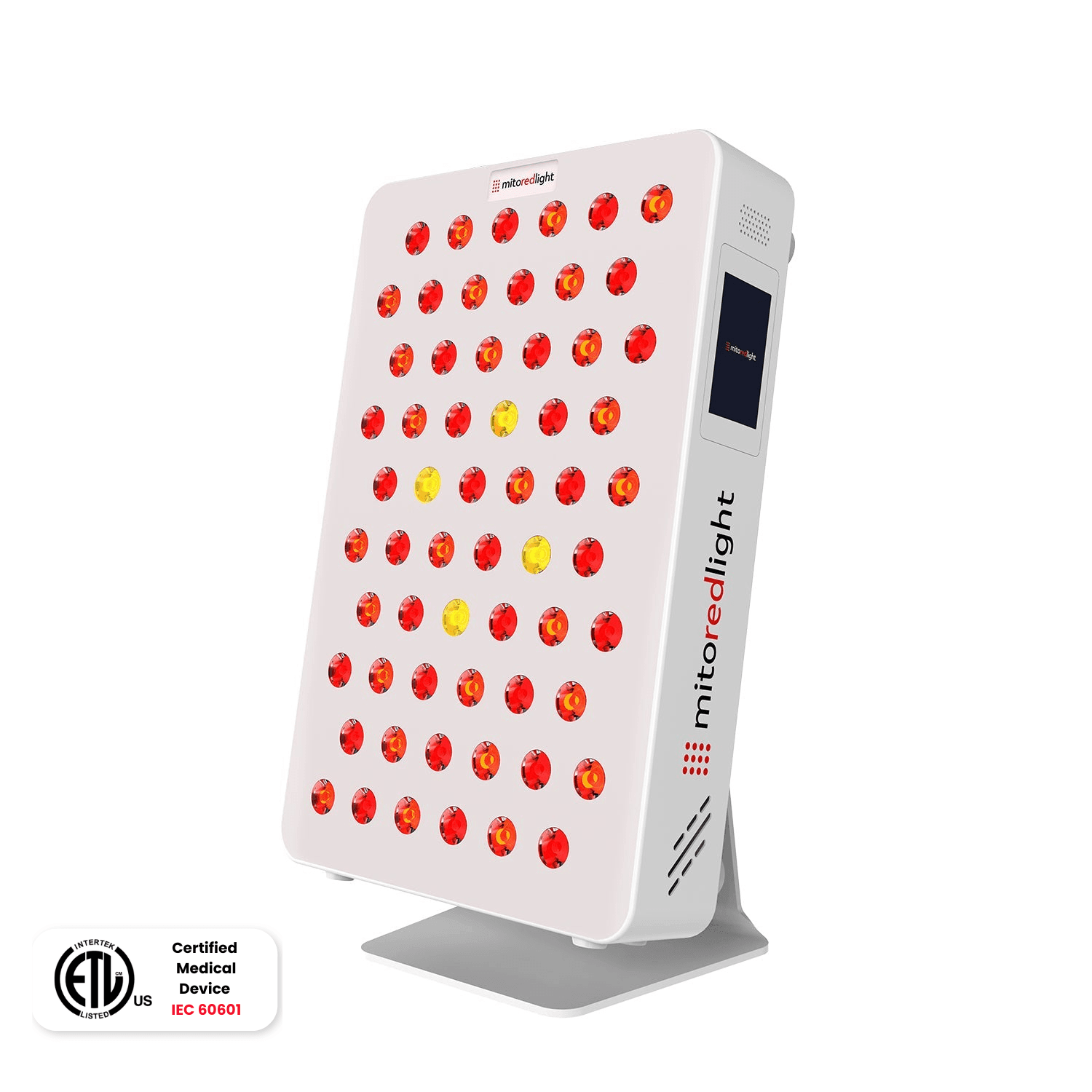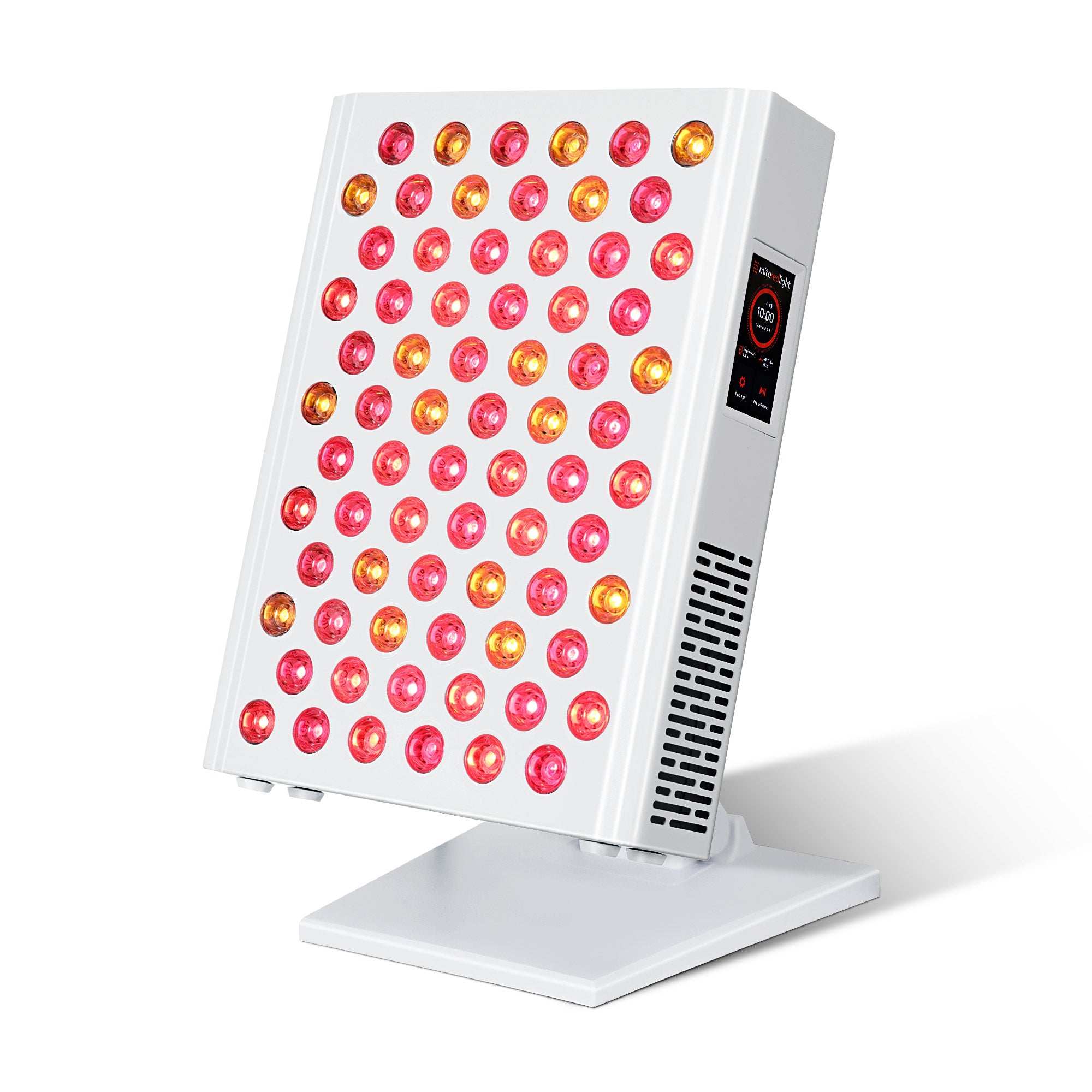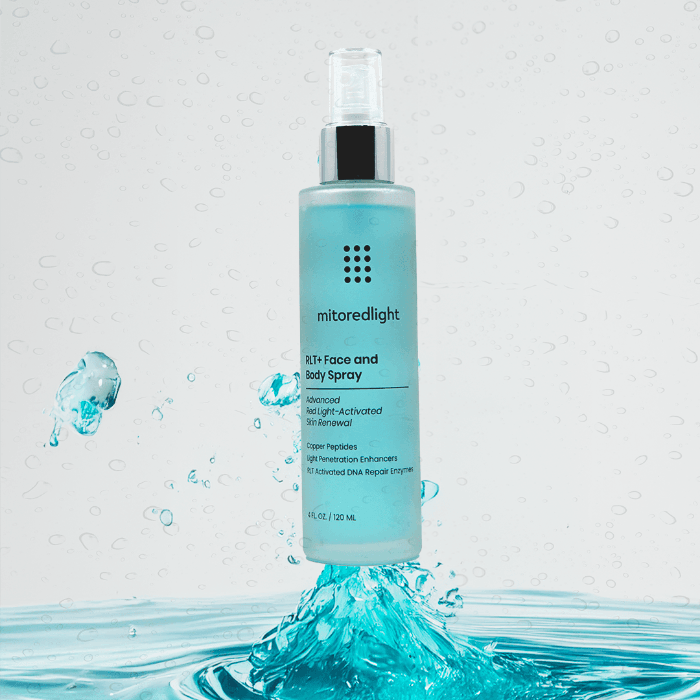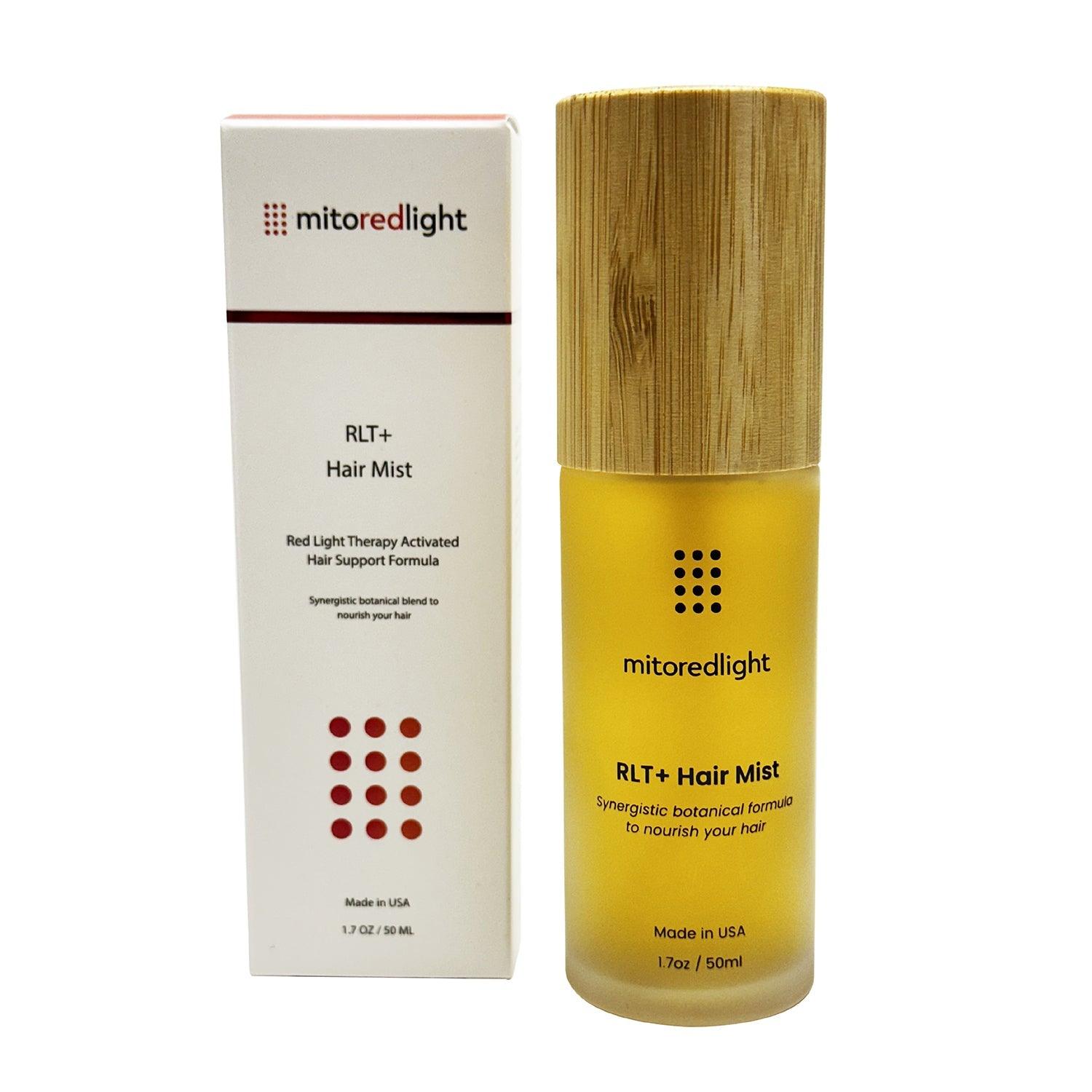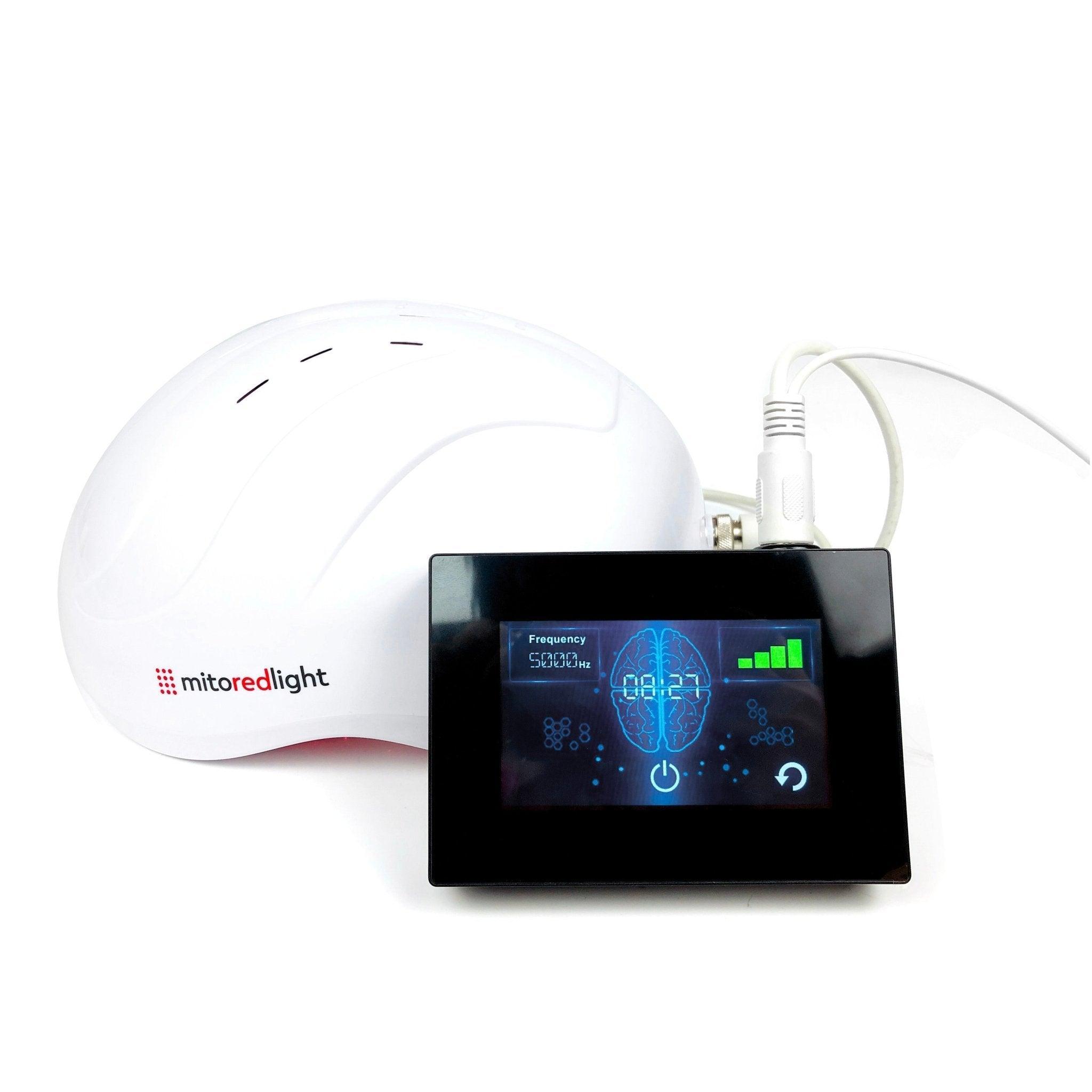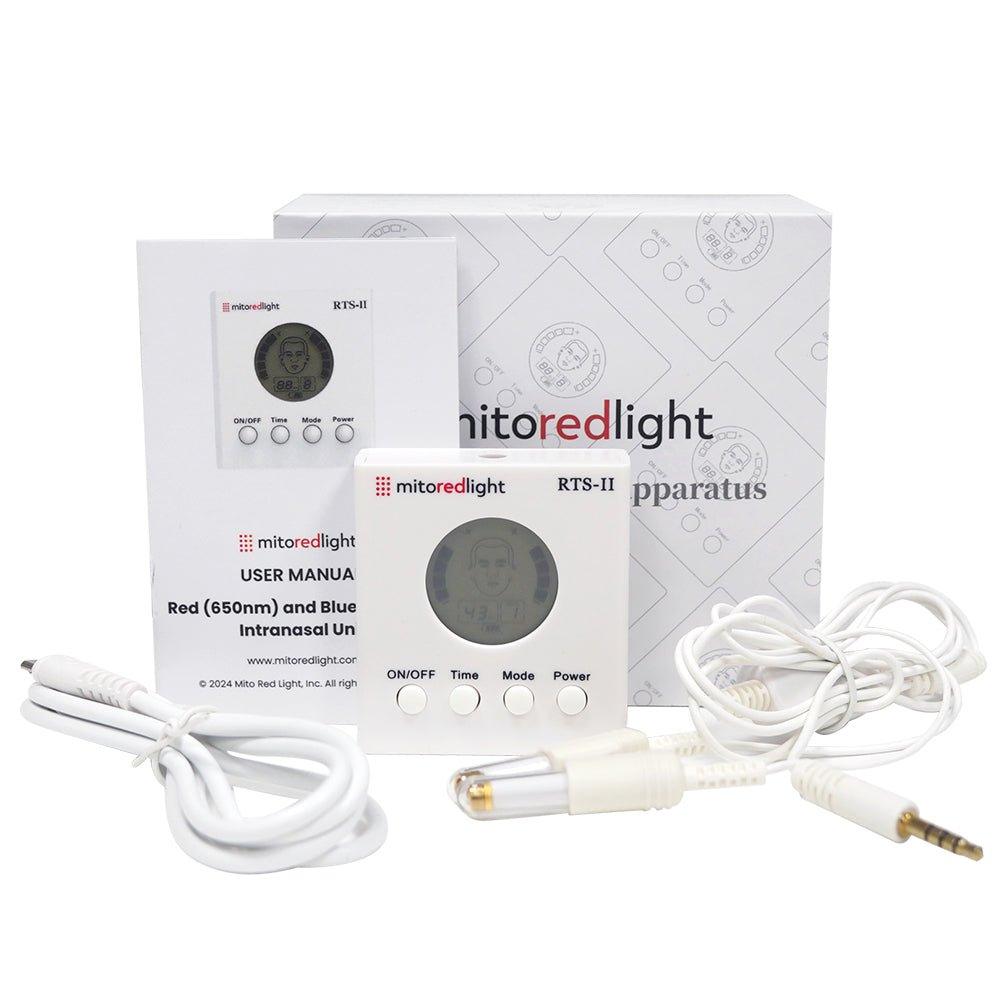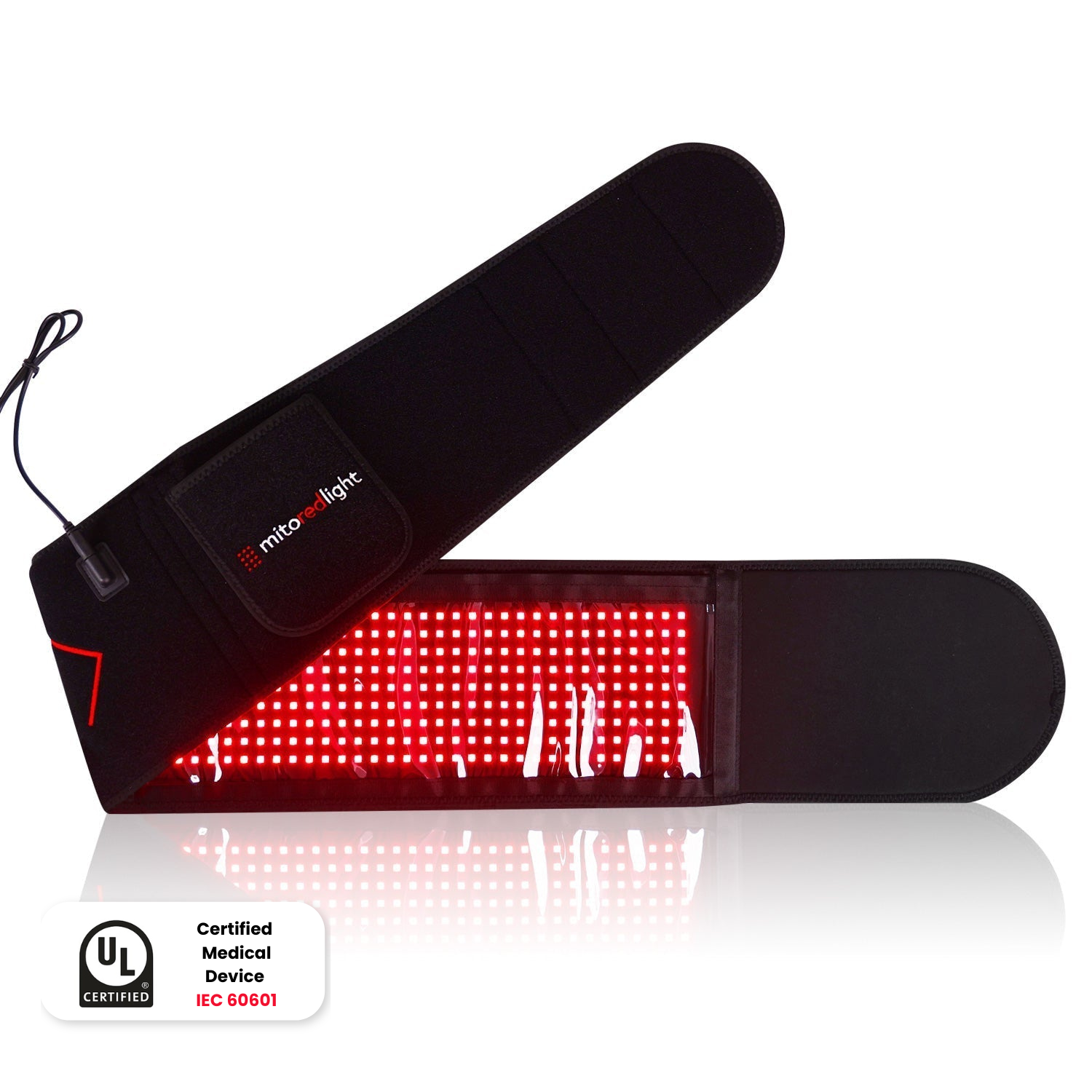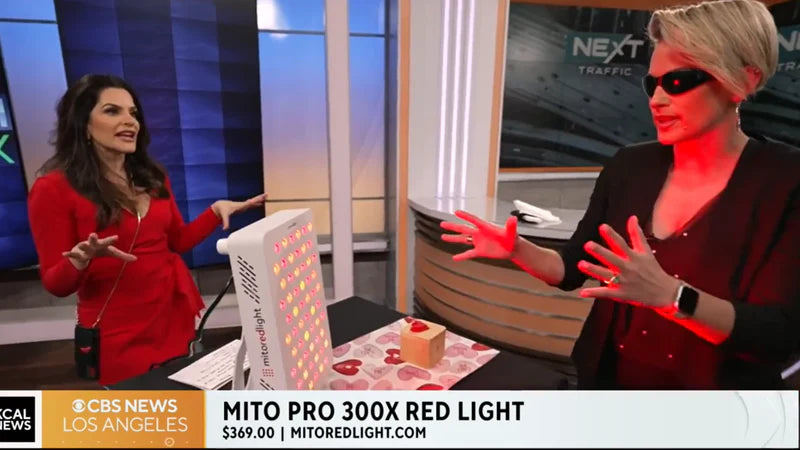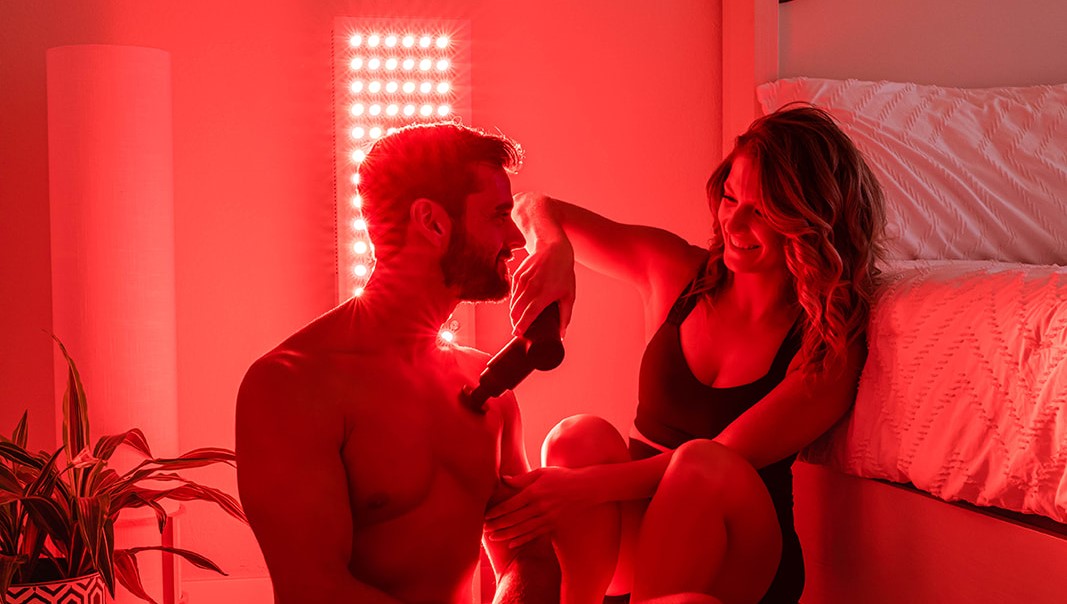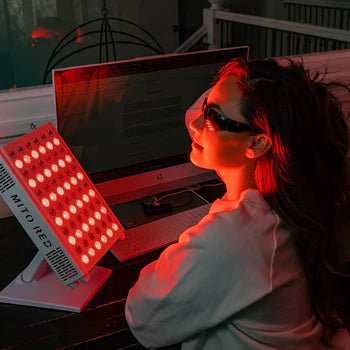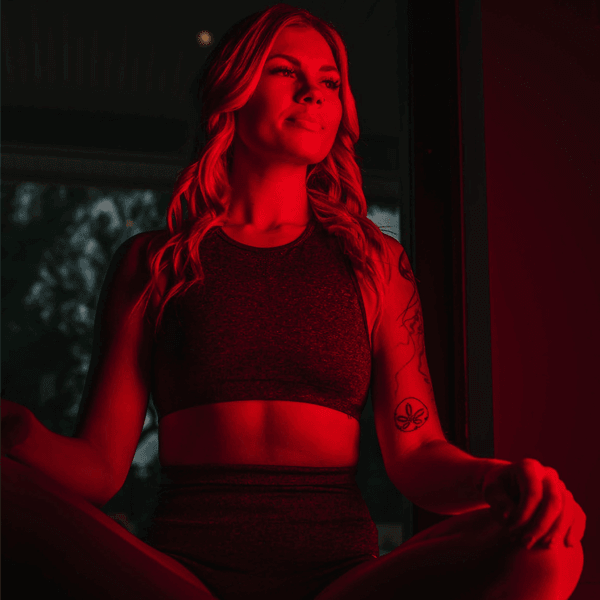DISCLAIMER: Mito Red Light devices are not clinically proven to diagnose, treat, cure, or prevent any medical conditions. Mito Red Light devices are low / risk general wellness devices aimed at affecting the body through supporting cellular function. The scientific studies referenced in this article are for educational and informational purposes only and are meant to educate the reader on the exciting and growing field of phototherapy. To see a list of precautionary warnings and contraindications, click here
There are more skincare treatment options than ever before and one of the latest, and arguably the most promising, is blue light therapy. This technology has come a long way in the last few years, moving from sterile clinics and bulky, expensive machines to convenient and comfortable masks and wands that you can use in the comfort of your own home.
But what are the differences between the therapy sessions you can book with your local clinic and the ones you can receive at home using blue light therapy devices? Both can be effective, and both have pros and cons. We want you to make the most informed decision, so here’s what you need to know about clinical vs at-home blue light therapy.
Technology Comparison
At-home and clinical blue light therapy devices use similar wavelengths. The wavelength for blue light therapy falls between 400 and 500 nanometers, with the most optimal range considered to be between 400 and 470 nm. However, that doesn’t mean that the device you buy for home use is the same as the one used in your local clinic.
Clinics provide a much more intense option. They can also provide a level of control and precision typically not accorded to home users.
Sessions may be longer in a clinic, and it can also provide a tailored service, taking into account your needs and goals, and considering complementary medications (including photosensitizing creams that enhance the effects of blue light), while providing recommendations on caring for areas of focus once the session has ended.
It’s not for everyone, though. The intensity of these sessions means the downtime is much longer after the session, and there’s more that can go wrong. If you don’t follow the clinician’s advice and properly care for your skin, for instance, you run a risk of infection and creating long-lasting damage to your skin. These risks are negligible with at-home devices, and they are all but eliminated when the devices are used as instructed.
Effectiveness Research
Antibiotics are often prescribed for moderate to severe acne, but at a time when antibiotic resistance is raising some serious health concerns, some users are exploring blue light as part of their skincare routine where traditional products may not be used. Blue light therapy is one of those alternatives, and the need to find effective alternatives has driven a recent surge in blue light research.
Much of that research has yielded positive results.
One study, for instance, found that blue light therapy helped in addressing grade II and grade III acne. Participants in this study were given professional blue light therapy sessions twice a week before being compared to those who had been given a 5% solution of topical benzoyl peroxide.
Typically, it is not easy to find concrete research on at-home devices, as most trials are conducted in a clinical setting. But the prevalence of these devices has shone a spotlight on their effects and potential benefits, so there is no shortage of studies out there.
A 12-week study, for instance, tested at-home blue light and red light devices on women aged 12 to 40 presenting with mild to moderate acne. At the culmination of the study, most participants reported “significant improvements” in acne symptoms and skin appearance, leading researchers to conclude that it was an effective, easy-to-use, support option for those with mild to moderate acne.
In a similar study, participants receiving self-applied blue light therapy found it to be more effective than previous options, with noticeably fewer whiteheads and blackheads during the 28-day study period.
There have been few definitive studies on how at-home results compare to those received in a clinical setting, but it’s worth noting that many dermatologists recommend combining these two procedures, providing consumers with the best of both worlds—the convenience of at-home blue light therapy with the fast results offered by intense clinical sessions.
Cost Analysis Over Time
The intensity provided by a clinical blue light therapy session, in combination with the support offered by an experienced practitioner, is a major lure for consumers. But all of that expensive technology and those experienced clinicians come at a cost.
A single clinical blue light therapy session can cost anywhere from $50 to $250, depending on the location and experience of the practitioner. But that’s just one session, and even clinical sessions require multiple visits to get the desired results. For this reason, many clinics offer therapy packages at an average cost of between $1,000 and $2,000.
These sessions will provide regular, evenly spaced appointments to target specific skin concerns such as blemishes. They can run over the course of several weeks and will allow time for the skin to partially heal between sessions.
It’s a lot of money, but considering the results that these sessions can provide, many consumers deem it to be a sound investment.
At-home blue light therapy is much cheaper in the long term and even in the short term. You can get a high-quality red light therapy mask for less than $500. It comes with everything that you need to conduct regular sessions, and in this case, it also has multiple modes and can switch between red light and blue light therapy.
High-quality devices like those sold here can be used several times a week for as long as you need them. You can work them into your usual skincare regime, and if you stick to the guidelines and use it as instructed, you may notice visible improvement within a few weeks.
Of course, whether you’re buying an at-home device or booking regular clinic visits, continued use may be needed to maintain the appearance of improved skin. Dermatologists recommend regular maintenance sessions to keep acne breakouts to a minimum and ensure your skin remains fresh, smooth, and healthy.
If you have already paid your money for an at-home device, you can simply take it out as needed. If not, you’ll need to book another clinical package and pay that price all over again.
For example, let’s suppose that you’ve never tried blue light therapy before and want to test it for 4 weeks to see if it’s suitable for you. You could create an intensive, at-home routine for daily use or book a couple of weekly sessions with a local clinic.
Assuming an average cost of $400 for an at-home device and $1,500 for a clinical package, the former will cost you just over $14 per session, while the latter equates to $53.5 per day or about $187.5 per session. What’s more, if the at-home session is successful, you’ll still have your device, and every additional session will bring those average costs down.
Convenience Factors
At-home devices are clearly the more convenient option.
You buy the device, read the instructions, keep it charged, and then add it to your skincare regime. You can wear a mask or use a wand for 5, 10, or 15 minutes while going about your day.
You will need to gently wash the targeted area in advance and use plenty of moisturizer and sunscreen afterward, but it only takes a minute to wash your face, and if you’re spending money on an at-home blue light therapy device to better your skin health, there’s a good chance you’re already diligent when it comes to moisturizing and using sunscreen.
Clinical sessions are a different beast entirely. Your dermatologist will ensure you’re properly prepared, including a clean face, no makeup/sunscreen, and no harsh chemicals or scrubs. They may then give you additional medication to improve the light’s penetration, and while this can enhance the results, it will also make your skin very sensitive afterward.
Depending on the session intensity, you may be asked to avoid direct sunlight for a couple of days after the session and may also need to avoid exercise, saunas, hot baths, and any kind of strong lights, including those used in dental exams. Even if you find the time to book and prepare for an appointment, it won’t be easy to schedule a session knowing you can’t leave the house for a couple of days and must focus 100% on your skin health.
Professional Guidance Benefits
One of the benefits of clinical therapy that you don’t get with at-home devices is that you’ll have an expert dermatologist on hand to advise you on the best pre and post-session care. They’ll also be on the end of the phone if you experience any issues or need more advice.
Whether that benefit is worth the additional expense and inconvenience is for the individual to decide, but if it’s advice that you need, we have plenty of educational resources here on MitoRed. You can use these to properly prepare and stay on the right course.
In addition to washing your face and avoiding makeup, retinoid products, and harsh exfoliation, there are other things to consider when following an at-home regime:
Take a “Before” Picture
Blue light therapy is not a “one and done” thing, nor are the results instant. It takes several weeks and many sessions to see any noticeable benefits, and as the changes are often gradual, it’s hard to truly understand how much of a difference your device has made.
Take a “before” picture so you always have something to look back on. It may not seem like a big deal now, but after a few weeks, you’ll be grateful for that image.
Keep a Journal
Document every change in a journal, whether it’s an improvement in the texture of your skin or a reduction in sebum production and breakouts. Not only will you have something to look back on as you plot your progress, but you can also give that information to a dermatologist if you experience any issues or need to go down a different route.
Keep Reading
The more you know, the less likely you are to do something that could hinder your progress. When performed properly, blue light therapy is very safe, and there are few to no side effects. But if you make several mistakes along the way, the risk of adverse reactions increases, and you may damage your skin.
Take a look at our “learn pages” for guides on the proper use of red and blue light therapy. You can also find some useful guides in our blog, including this piece on the differences between red and blue light therapy.
Consider Some Combination Therapies
Blue light therapy is rarely used in isolation. Dermatologists often combine it with other treatment options, taking advantage of the fact that it is well tolerated, comes with few risks, and doesn’t have many contraindications. You can try some of these combinations at home, but you should always consult a professional first if you have any preexisting illnesses, take medication, or have had problems with your skin in the past.
-
Salicylic acid and benzoyl peroxide are very effective at supporting clearer looking skinwhen used in combination with blue light. They may also increase sensitivity, though, and should be used with caution.
-
Niacinamide, also known as vitamin B3, provides some protective benefits to support your skin health.
-
Don’t use any harsh chemicals or exfoliators, though, as they may not support your skin’s complexion.
Ideal Candidates for Professional Treatment
The intensity of clinical blue light sessions mean it’s not suitable for everyone. You should avoid this option if you have any kind of photosensitivity disorder (such as porphyria) or take a medication that increases photosensitivity (such as lithium and certain antibiotics). It’s not recommended for pregnant woman, as there is very little research concerning its long-term effects on the mother or baby.
As noted above, it’s also not the best option for people who lead busy lives and spend a lot of time outdoors, as it may be hard to work clinical sessions around your schedule. Budget options are a concern, as well. At a few hundred dollars, at-home devices aren’t cheap, but as you’ll need several sessions to complete your skincare routine, and those sessions can cost anywhere from $50 to $250, the expense of clinical therapy can escalate very quickly.
Ideal Candidates for At-Home Therapy
If you don’t qualify for clinical sessions because of the issues mentioned above, we recommend consulting a dermatologist before purchasing any device for use in your own home. They may recommend avoiding any kind of light therapy (definitely not advised if you are pregnant or have porphyria) or advise more caution and provide some alternatives.
You also need to be self-motivated. Blue light therapy devices are seen as the “next big thing” right now, so many consumers are rushing out to buy them, only to neglect actually using them. If you want the best outcome for your skin, you need to follow through with the regimen, and that means using it on a regular basis and incorporating it into a considered skincare regime.
Needless to say, these devices are definitely more suitable for budget-conscious consumers. Just make sure you don’t rush out and buy the cheapest device that you can find. It’s a false economy, as while it might only save you a few bucks in the short-term. It could break and force you to buy another, it could harm your skin, or it might just not work, in which case it doesn’t matter how much you spent; it was still too much.
Conclusion
At-home and clinical blue light therapy are both effective ways to improve the appearance of your skin. But there are clear differences between the two.
Clinical sessions are more intense and more effective in the short term, but they’re also much more expensive and not as convenient. At-home devices are easier to add to your skincare regime and more cost-effective, but the results may take more time to develop.
If you have time for the occasional clinical appointment, but don’t want to spend over $1,000 on a full package, consider booking an appointment, getting some advice from your dermatologist, and then topping-up those results with an at-home device.
